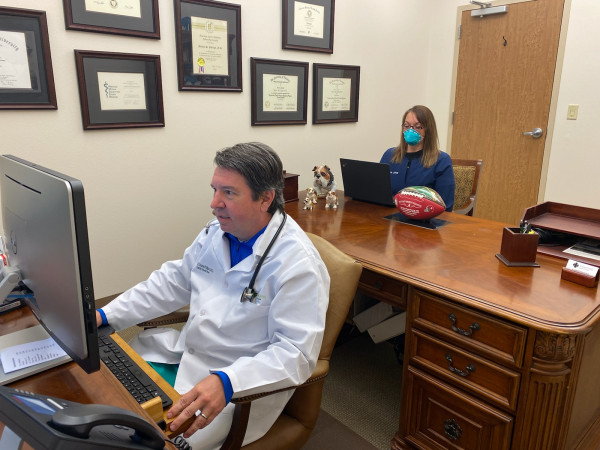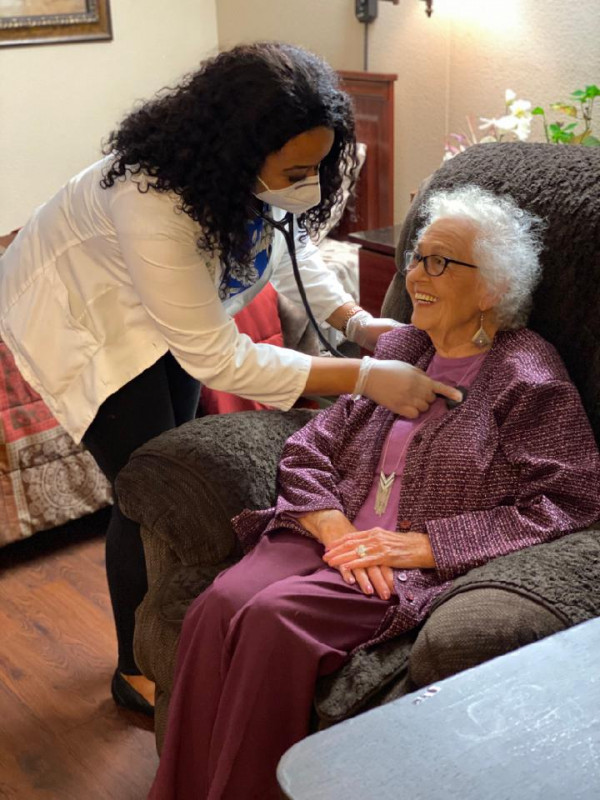On front lines at nursing homes

Photo by JILL COBB
Dr. Shane Phillips and his nurse, Misty Luginbill, perform telemedicine rounds at Princeton Place from his office at Green Clinic Northside.

Photo by JESSICA BENNETT
Dr. Shane Phillips’ Nurse Practitioner Ekara Wafer-Mendenhall examines Celeste Franklin while completing rounds at Alpine Skilled Nursing and Rehabilitation.
When the first COVID-19 cases were reported, Green Clinic physician Shane Phillips said he was anxious and concerned that things could get bad very quickly.
“Initially, I talked to our IT Director at Green Clinic about implementing a plan to get telemedicine available for all of the physicians,” Phillips said. “Fortunately, we were prepared when the Louisiana State Board of Medicine began to limit face-to-face office visits.”
A physician in Ruston since 2003, Phillips has a full-time private practice with Green Clinic Northside while being associated with several other entities including medical director for Princeton Place and Alpine Skilled Nursing and Rehabilitation. Yet with 75% of all daily visits currently done via telemedicine, he said it has created a new normal.
“It’s been a challenge,” Phillips said. “As a primary care physician, I have been trained to take patient histories and examine them physically. With telemedicine playing such a large role, it has been a learning process to be able to ask crucial questions and provide the best care for your patient without being able to do a hands-on exam.”
However, caring for nursing home patients via telemedicine during the pandemic presented a new set of challenges for Phillips. He reports that nursing home patients have multiple chronic medical illnesses and adverse reactions to medications are significantly higher. Polypharmacy, or multiple medications, is also an issue. Furthermore, many nursing home residents have dementia and are unable to give a history, causing physicians to make an initial guess about the cause of behavioral changes.
Because of these reasons, Phillips is involved with medical directors of other area nursing homes to develop protocols for their patients.
“There is no universal protocol for nursing homes,” Phillips said.
“Each nursing home and medical staff developed an individualized protocol for patients when they test positive for COVID-19. When the pandemic started, only patients that were symptomatic were tested. If positive, they were then isolated.
“Most of the nursing homes have developed a designated COVID-19 wing where patients who test positive are immediately transferred. A COVID-19 patient who exhibits worsening symptoms would be transferred to an acute care hospital equipped to handle critically ill patients.”
To help fight the spread of COVID-19, Phillips said only essential staff is allowed in nursing homes. Other strategies include outside hand sanitizing areas, checking everyone’s temperature before entering, and not allowing staff to leave the facility during shifts.
Many facilities are also testing all residents and staff for COVID-19, regardless of symptoms, in order to provide surveillance for the different facilities and protect both residents and employees. Phillips also said despite some reports, there are no approved medications for patients.
“In the early stages, some drugs were looked at to try and improve symptoms or decrease mortality. But there have been mixed results and no conclusive data that any medications decrease the mortality rate in COVID-19 patients. There is another drug undergoing clinical trials and showing possible benefits but is only recommended to be given in hospitalized patients and not in a nursing home setting.”
While Phillips is ready for life to get back to normal, he warns that the community is not yet ready to return to the way things were before the pandemic. Citing the need to constantly wash hands and wear masks, he said it is crucial we do our best to continue following the advice of medical experts in this field.
That means being both smart and safe, something he said the staff caring for themost vulnerable is doing so well.
“The nurses and staff at the nursing home and assisted living facilities have been just incredible,” Phillips said. “They understand the risks of caring for people in a situation where exposure is always a possibility, yet every day they show up to help people who cannot care for themselves at home and do their best to help residents stay in contact with family members who can’t visit them. All physicians and those working in health care understand the risks associated with our profession, but most will probably tell you that they worry about their families more than themselves.”

